Info on the first two titles from Nintendo
- Genre: Puzzle/Platformer
- Platform: 3DS (eShop)
So ya, technically speaking this isn’t out in the US yet. However, that fancy triple pack is out in Japan, so I had to jump at it. The TL;DR on this series is that you play a Box…Boy that is able to spawn chains of blocks connected to his body. You use these chains to traverse puzzle-based levels, with each world tending to be built around a series of levels with one new core mechanic. While the gameplay of this third title is still built around that core, HAL Labs has again managed to bring a lot of new mechanics in to give another 20+ worlds of damn good puzzle solving.
If there’s one core theme that this game was built on, I’d say it was motion. Sure, the core box chain puzzles from the first two games are there, but a lot of the new mechanics are all based around exploiting motion in some way. Just a few of the many examples of some of the smart ways they used motion:
- Forced movement through the use of conveyors, moving platforms, velocity-adding volumes, and water meant that timing became a lot more important puzzle-solving mechanic than just setting up chains of blocks.
- The inclusion of things like explosives allowed for some fantastic puzzles based around blocks falls.
- AI-based levels added secondary characters into the mix. In particular, there were a number of escort levels that were actually fun (I’m being serious here). There were some smart decisions in the use of AI, in particular the fact that the AI will not move forward if its path is dangerous. It simply waits for you to makes things safe for it.
- Gravity-based mechanics also came through a lot, with some really smart levels based around reversal of gravity, as well as levels based on weight through scales.
Each of the first 15 or so worlds tended to have one new mechanic in it. The last 10 or so worlds and challenge worlds are where things really got interesting. The final handful of worlds did a great job of taking the individual mechanics, and mixing them into multi-mechanic levels that test both a late night sleep deprived brain, as well as my patience in a lot of areas. That said, this is some of the best puzzle-platform gameplay that the 3DS has seen. Of particular note, the challenge worlds offer some mischievous changes, such as not being able to jump, or not being able to fall more than 1 block’s height.
There’s really not much to say here if you’ve played either of the first two titles in the series. The core of the game is the same, and the new mechanics are fantastic. If you’ve got a Japanese 3DS, it’s definitely worth picking up the triple pack if you’re a collector. Otherwise, until this gets to the US, 3DS owners have another great title to look forward to.


